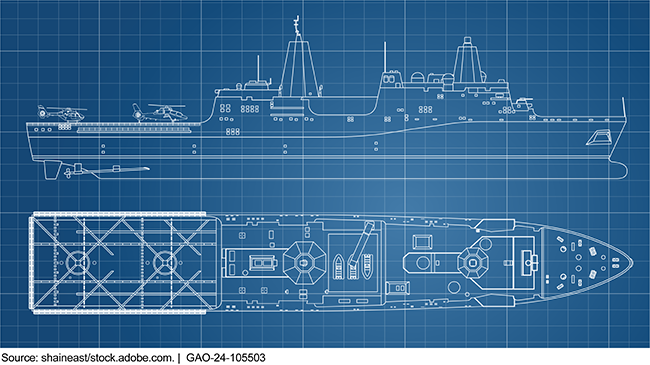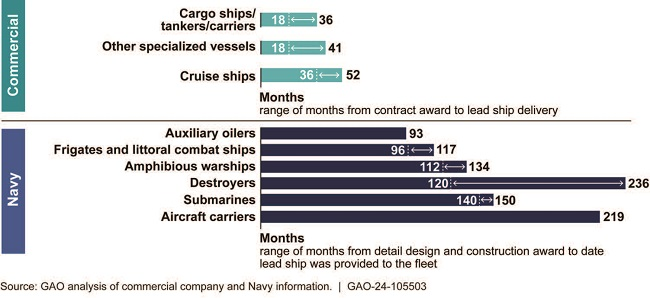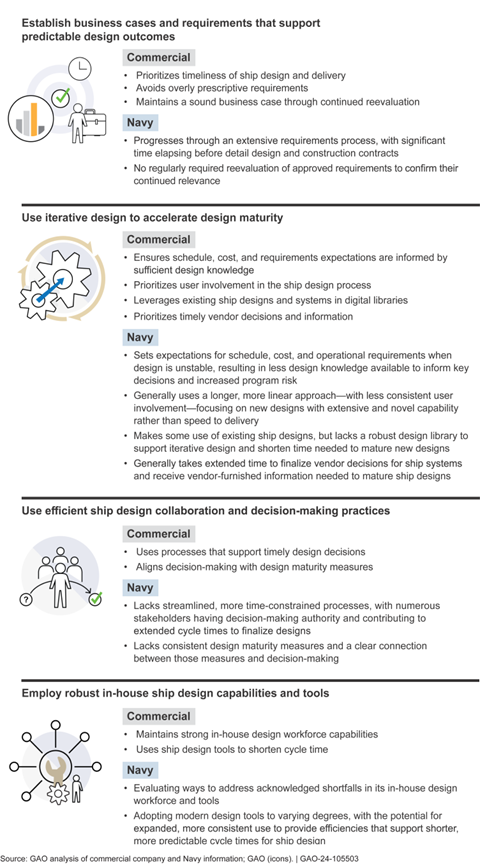Navy Shipbuilding: Increased Use of Leading Design Practices Could Improve Timeliness of Deliveries
Fast Facts
Rapidly changing maritime threats compel the Navy to deliver ships faster. But the Navy falls short on design practices that reduce leading companies' shipbuilding time.
For example, companies:
Use existing ship designs—limiting changes to a section of the ship—to create new designs, allowing companies to stabilize designs sooner and better estimate schedules
Empower a small group of decision makers to use their expertise to get through the design process quickly
In contrast, the Navy often creates new ship designs and has many stakeholders in a lengthy decision-making process.
We recommended the Navy apply these and other leading practices.

Highlights
Why This Matters
Changing maritime threats are pushing the U.S. Navy to increase its pace for designing and delivering new ships. Since 2009, GAO has used leading practices in commercial shipbuilding to evaluate the plans and execution of Navy shipbuilding programs. GAO’s numerous recommendations have spurred Navy action to improve acquisition practices and the use of taxpayer dollars. Yet, the Navy has continued to face persistent challenges in its ability to design and deliver timely, affordable new ships that perform as expected.
Computing power and digital design capabilities have rapidly changed in the 15 years since GAO first identified leading ship design practices. As a result, GAO’s examination of commercial industry’s current practices helps ensure that the activities and performance of the Navy’s shipbuilding programs are evaluated against cutting-edge practices used to design new ships efficiently and effectively.
Key Takeaways
GAO found that leading commercial ship buyers and builders prioritize shorter, predictable periods for design and construction, which result in delivering timely ships that meet current user needs. In contrast, the Navy's approach often results in significantly longer design and construction cycle times for its shipbuilding programs' lead ships.
Comparison of Design and Construction Cycles for Selected Commercial and Navy Ships

Note: For commercial ships, the range of months indicates the shortest and longest typical periods for companies to deliver a ship after contract award. For Navy ships, the range of months for different ship types indicates the shortest and longest periods for the Navy to provide selected lead ships to the fleet since 2007. For Navy programs with a contract prior to the detail design and construction award, the earlier award date represents the start of the cycle.
Key differences between commercial companies' and the Navy's ship design practices contribute to the slower pace and less predictable cost, schedule, and performance outcomes for Navy shipbuilding programs. Leading design practices involve
- effective management of a ship's business case—a reflection of the balance of customer needs and the resources needed to develop and produce the ship; and
- focus on efficiently maturing new ship designs to better inform decisions on schedule, cost, and performance. This includes using consistent, meaningful design maturity measures to determine readiness to move from design to construction.
GAO Comparison of Leading Ship Design Practices for Commercial Companies and U.S. Navy

How GAO Did This Study
A conference report directed GAO to examine ship design practices. This report assesses (1) the leading design practices used by commercial ship buyers and builders to inform their understanding of design maturity and readiness for construction, and (2) how the Navy’s ship design practices compare to the leading practices in commercial ship design. To address these objectives. GAO interviewed and reviewed documentation from four commercial ship buyers and five shipbuilders—builders generally also design the ships. GAO selected these companies using criteria reflective of commercial success in designing, building, and buying ships relatable to Navy ships. GAO also reviewed its prior work on leading practices for shipbuilding and product development. In addition, GAO reviewed documentation and interviewed representatives from the Navy and selected Navy shipbuilders, as well as reviewed prior work on Navy shipbuilding program efforts. Based on the results of these activities, GAO compared the ship design practices used by the Navy with leading commercial practices.
Recommendations
GAO is raising to the attention of Congress three matters for its consideration regarding reporting and certification requirements. The matters would enable Congress to gain additional information on design maturity for Navy shipbuilding programs. GAO is also making eight recommendations to the Secretary of the Navy, which are intended to support improvements to the Navy’s design approach, decision-making practices, and design capabilities that facilitate more timely, predictable outcomes for its shipbuilding programs. The Navy agreed with seven recommendations and partially agreed with one recommendation. GAO continues to believe that all eight recommendations should be fully implemented.
Matter for Congressional Consideration
| Matter | Status | Comments |
|---|---|---|
| Congress should consider updating statutory certification and production readiness review reporting requirements for Navy shipbuilding programs under section 8669c of title 10 United States Code, to require certification of the completion of basic and functional design in 3D modeling and the positioning and routing of all major distributive systems prior to the start of construction (consistent with leading industry practices in ship design). (Matter for Consideration 1) | As of February 2025, Congress has taken action that partially addresses this matter. In Section 1024 of the Servicemember Quality of Life Improvement and National Defense Authorization Act for Fiscal Year 2025, Congress amended section 8669c of title 10, United States Code, related to Navy certification requirements for Navy vessel designs prior to the start of construction. Specifically, the amendments require that the Navy's certification of basic and functional design for crewed surface and undersea combatant vessels is based on 3D modeling and the positioning and routing of all major distributive systems. These amendments address part of this matter, but do not include a requirement for 100 percent completion of basic and functional design prior to the start of construction, consistent with leading ship design practices. Instead, the amendments establish a requirement for at least 95 percent of all basic and functional design drawing packages for the ship have reached final approval. As a result, we will continue to monitor congressional actions to align Navy ship design requirements with leading practices. | |
| Congress should consider requiring, as part of section 8669c of title 10, United States Code, that the Navy certify that detail design will be completed for each block of a ship's construction before beginning construction of that block. (Matter for Consideration 2) | As of February 2025, Congress has yet to take action that would address this matter. While Congress took action in the Service Member Quality of Life Improvement and National Defense Authorization Act for Fiscal Year 2025 to better align Navy ship design requirements, no action was taken related to this matter. Further, we did not identify any other congressional action that addresses this matter. We will continue to monitor congressional action related to ensuring that--consistent with leading ship design practices--detail design for Navy vessels is completed for each block of a ship's construction before beginning construction of that block. | |
| Congress should consider requiring, as part of section 8669c of title 10, United States Code, that the Navy report on the degree of vendor-furnished information completeness supporting the overall maturity and stability of a ship's design before beginning construction. (Matter for Consideration 3) | As of February 2025, Congress has taken action that fully addresses this matter. Specifically, Congress took action through section 1024 of the Servicemember Quality of Life Improvement and National Defense Authorization Act for Fiscal Year 2025 related to reporting on vendor-furnished information. This action amends section 8669c of title 10, United States Code, to require that Navy reporting identifies the extent to which vendor- and government-furnished information supports the overall maturity and stability of the ship's design. This includes information regarding whether vendor selection is complete for major distributive systems and key equipment supporting operational requirements, whether specifications are finalized for major distributive systems and key equipment, and the status of factory acceptance testing, as applicable, to validate finalized specifications for major distributive systems and key equipment through manufacturing. This congressional action is consistent with the intent of our matter and supports closing it as implemented. |
Recommendations for Executive Action
| Agency Affected | Recommendation | Status |
|---|---|---|
| Department of the Navy | The Secretary of the Navy should ensure that each shipbuilding program reevaluates validated requirements in capability development documents before the start of construction for individual ships and periodically during ship construction to confirm their continued relevance and identify any appropriate changes. (Recommendation 1) |
The Navy concurred with our recommendation but, as of July 2025, has yet to demonstrate actions to implement it. In July 2025, the Department of Defense provided information stating that the Navy will continue to evaluate validated requirements at annual Gate Reviews and Configuration Steering Boards. The Navy also stated that its fleet provides recommendations based on its operational experience for new ship requirements as part of annual budget planning activities. The Navy stated plans to provide documentation in fiscal year 2026 demonstrating the results of its reevaluation actions for shipbuilding programs that undergo Gate Reviews. The Navy's demonstration of such actions could partially address this recommendation. However, the Navy's stated actions lack clarity on whether they apply to decision-making for each ship in a class prior to the start of its construction. We will continue to monitor the Navy's actions in response to this recommendation to ensure that the requirements for each new ship remain relevant before proceeding with construction.
|
| Department of the Navy | The Secretary of the Navy should ensure that shipbuilding programs complete functional design for new ships before awarding detail design and construction contracts. (Recommendation 2) |
The Navy partially concurred with our recommendation but, as of July 2025, has yet to demonstrate actions to implement it. In July 2025, the Department of Defense provided information stating that the Navy will comply with amendments to section 8669c of title 10, United States Code, which requires reporting of specific basic and functional design drawing package process. The Navy, however, stated that it is not necessary for functional design to be 100 percent complete before awarding a detail design and construction contract. As we found in our May 2024 report, completing 100 percent of basic and functional design before awarding a detail design and construction contract is a leading practice for ship design used by commercial industry. Achieving a stable ship design through the completion of functional design helps establish more predictable cost and schedule expectations before entering into contracts. Given our findings that such practices help better ensure that shipbuilding outcomes reflect expectations, we maintain that the Navy should implement this recommendation and will continue to monitor any actions to do so.
|
| Department of the Navy | The Secretary of the Navy should ensure that the design teams for new ship designs include user representation, such as current or recent operators and engineers from the Navy's fleet, to provide consistent, direct user input in the design review process and inform decision-making. (Recommendation 3) |
The Navy concurred with our recommendation but, as of July 2025, has yet to demonstrate actions to implement it. In July 2025, the Department of Defense provided information stating that Navy policy incorporates fleet and user inputs into the design process and that active duty and civilian subject matter experts are detailed into acquisition and design positions where they provide feedback into the design review process. The Navy stated plans to provide documentation in fiscal year 2026 demonstrating fleet participation and input in design reviews. The Navy's demonstration of such actions could partially address this recommendation. However, the Navy's stated actions lack clarity on whether they would ensure consistent user input through user representation on design teams. We will continue to monitor the Navy's actions in response to this recommendation to help ensure its design decisions fully account for the needs of its sailors.
|
| Department of the Navy | The Secretary of the Navy should develop a robust digital ship design library to enhance the Navy's ability to leverage existing designs and expedite design and construction. (Recommendation 4) |
The Navy concurred with our recommendation but, as of July 2025, has yet to demonstrate actions to implement it. In July 2025, the Department of Defense provided information stating that the Navy will design and develop an integrated digital ship design library. The Navy stated plans to provide documentation in fiscal year 2031 demonstrating the development of this design library. We will continue to monitor the Navy's progress to increase its inventory of existing design knowledge and its efficiency in maturing and validating new ship designs.
|
| Department of the Navy | The Secretary of the Navy should—in coordination with Navy shipbuilders—evaluate opportunities to accelerate the receipt of reliable vendor-furnished information to support earlier design maturity for new ships. (Recommendation 5) |
The Navy concurred with our recommendation but, as of July 2025, has yet to demonstrate actions to implement it. In July 2025, the Department of Defense provided information stating that the Navy will comply with amendments to section 8669c of title 10, United States Code, which added requirements for Navy reporting to identify the extent to which vendor- and government-furnished information supports the overall maturity and stability of the ship's design. These requirements include reporting of information regarding whether vendor selection is complete for major distributive systems and key equipment supporting operational requirements, whether specifications are finalized for major distributive systems and key equipment, and the status of factory acceptance testing, as applicable, to validate finalized specifications for major distributive systems and key equipment through manufacturing. The Navy stated that it expects to provide documentation in fiscal year 2028 demonstrating efforts to receive vendor furnished information in a more timely manner and to ensure it adequately supports detailed design reviews and production readiness reviews. However, this stated plan does not make clear that the Navy intends to coordinate with Navy shipbuilders to evaluate opportunities to accelerate receipt of vendor-furnished information, consistent with this recommendation. We will continue to monitor the Navy's actions in response to this recommendation to support improvements to the timeliness of vendor-furnished information and design maturity for new Navy ships.
|
| Department of the Navy | The Secretary of the Navy should evaluate the response timelines for reviewing and approving design products and the sufficiency of the Navy's resources supporting design review and decision-making processes to identify any opportunities to shorten design review timelines. (Recommendation 6) |
The Navy concurred with our recommendation but, as of July 2025, has yet to demonstrate actions to implement it. In July 2025, the Department of Defense provided information stating that the Navy is assessing how government and industry ship design workforce resources support the shipbuilding design, review, and decision-making process. The Navy also stated that it expects to provide documentation in fiscal year 2027 demonstrating that it has completed this review. We will continue to monitor the Navy's actions in response to this recommendation to ensure timely design decision-making.
|
| Department of the Navy | The Secretary of the Navy should establish—and regularly update, as needed— guidance outlining the information and evaluation methodology used to certify the completion of basic and functional design prior to a ship's construction start for any major shipbuilding program, to include the Navy's explanation of what design activities and outputs must be accomplished to meet the statutory requirement for completion of a ship's basic and functional design. (Recommendation 7) |
The Navy concurred with our recommendation but, as of July 2025, has yet to demonstrate actions to implement it. In July 2025, the Department of Defense provided information stating that the Navy will comply with amendments to section 8669c of title 10, United States Code, which updated requirements on the information used to certify the completion of basic and functional design prior to a ship's start of construction. The Navy expects to provide documentation of entrance criteria for the production readiness review of a yet to be chosen major shipbuilding program reaching this milestone by fiscal year 2026. While information provided through the entrance criteria of an individual program may help clarify the methodology used to support certification of the associated program, it will not demonstrate that the Navy has established guidance that will support consistent expectations for the information and methodology used for future design certification decisions across Navy shipbuilding programs. We will continue to monitor the Navy's actions in response to this recommendation to ensure that it establishes the recommended guidance to support consistent expectations in the Navy's approach to its certification decisions for shipbuilding programs.
|
| Department of the Navy | The Secretary of the Navy should evaluate opportunities to increase the use of modern design tools, including digital twinning and virtual or augmented reality. (Recommendation 8) |
The Navy concurred with our recommendation but, as of July 2025, has yet to demonstrate actions to implement it. In July 2025, the Department of Defense provided information stating that the Navy will continue to evaluate opportunities to leverage modern design tools throughout the ship's lifecycle. The Navy also stated it is investing in digital twinning and virtual or augmented reality, along with 3D capabilities, to visualize design changes and detect interference. It also stated that it expects to provide documentation in fiscal year 2028 demonstrating 3D product model environments. While these actions may support increased use of modern design tools, they do not clearly demonstrate actions by the Navy to evaluate its opportunities to increase its use of such tools. We will continue to monitor the Navy's actions in response to this recommendation to ensure that the Navy demonstrates it has evaluated options for expanding its use of modern tools in support of its ship design activities.
|
